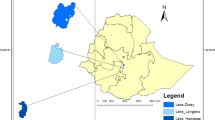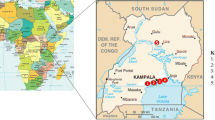Abstract
The present study focuses on bacterial and selected heavy metal contaminations of economically important mullet fish (Mugil cephalus) collected from West coast of Gujarat, India. Molecular identification using 16S rRNA sequencing revealed the presence of Aeromonas veronii, A. mollusorum, A. cavae, A. bivalvum, and V.alginolyticus in the gill and the intestine along with some other non-pathogenic bacteria. Pathogenicity of different Aeromonas species was confirmed by hemolysin assay. Apart from pathogenicity, multidrug resistance pattern was also reported against some commonly used antibiotics. Heavy metal analysis of different parts such as ventral and dorsal muscles as well as gills of M. cephalus revealed maximum concentration of Pb (24.08 ± 4.40 mg/kg), Cd (8.25 ± 3.04 mg/kg), and Cu (33.67 ± 5.34 mg/kg), which were higher than the permissible limit. To the best of our knowledge, this is the first study analyzing different heavy metals and associated bacteria in M. cephalus fish in India. Further, the distribution of heavy metals in M. cephalus fish from other countries was also compared.








Similar content being viewed by others
References
Abdel-Baki A, Dkhil M, Al-Quraishy S (2011) Bioaccumulation of some heavy metals in tilapia fish relevant to their concentration in water and sediment of Wadi Hanifah, Saudi Arabia
Al-Benwan K, Abbott S, Janda JMJM et al (2007) Cystitis caused by Aeromonas Caviae. J Clin Microbiol 45:2348–2350. doi:10.1128/JCM.00480-07
Albert MJ, Ansaruzzaman M, Talukder KA, Bradleysack RO, Mollby R et al (2000) Prevalence of enterotoxin genes in Aeromonas spp. isolated from children with diarrhea, healthy controls and …. J Clin Microbiol 38:3785–3790
Bahnasawy M, Khidr AA, Dheina N et al (2009) Seasonal variations of heavy metals concentrations in mullet, Mugil cephalus and Liza ramada (Mugilidae) from Lake Manzala, Egypt. J Appl Sci Res 5:845–852
Ben-Amor K, Heilig H, Smidt H et al (2005) Genetic diversity of viable, injured, and dead fecal bacteria assessed by fluorescence-activated cell sorting and 16S rRNA gene analysis. Appl Environ Microbiol 71:4679–4689
Bonhoeffer S, Lipsitch M, Levin BR (1997) Evaluating treatment protocols to prevent antibiotic resistance. Proc Natl Acad Sci 94:12106–12111
Bridges CC, Zalups RK (2005) Molecular and ionic mimicry and the transport of toxic metals. Toxicol Appl Pharmacol 204:274–308
Cabello FC, Godfrey HP, Tomova A et al (2013) Antimicrobial use in aquaculture re-examined: its relevance to antimicrobial resistance and to animal and human health. Environ Microbiol 15:1917–1942
Caccamese SM, Rastegar DA (1999) Chronic diarrhea associated with Vibrio alginolyticus in an immunocompromised patient. Clin Infect Dis 29:946–947
Castro-González MI, Méndez-Armenta M (2008) Heavy metals: implications associated to fish consumption. Environ Toxicol Pharmacol 26:263–271. doi:10.1016/j.etap.2008.06.001
Chopra AK, Houston CW (1999) Enterotoxins in Aeromonas-associated gastroenteritis. Microbes Infect 1:1129–1137
Chopra AK, Houston CW, Kurosky A (1991) Genetic variation in related cytolytic toxins produced by different species of Aeromonas. FEMS Microbiol Lett 78:231–237
EC (2001) Commission regulation (EC) No 353/2007
FAO (1983) Compilation of legal limits for hazardous substances in fish and fishery products. FAO, Rome, Italy, p 1–102
FDA US (2001) Fish and fisheries products hazards and controls guidance. Food and drug administration. Center for Food Safety and Applied Nutrition, Washington, DC
Felsenstein J (1985) Confidence limits on phylogenies: an approach using the bootstrap. Evolution (N Y):783–791
Finney BP, Huh CA (1989) History of metal pollution in the Southern California bight: an update. Environ Sci Technol 23:294–303
Forti E, Salovaara S, Cetin Y et al (2011) In vitro evaluation of the toxicity induced by nickel soluble and particulate forms in human airway epithelial cells. Toxicol Vitr 25:454–461
Fosmire GJ (1990) Zinc toxicity. Am J Clin Nutr 51:225–227
Gibson RS, Yeudall F, Drost N et al (2003) Experiences of a community-based dietary intervention to enhance micronutrient adequacy of diets low in animal source foods and high in phytate: a case study in rural Malawian children. J Nutr 133:3992S–3999S
Goldberg ED, Gamble E, Griffin JJ, Koide M (1977) Pollution history of Narragansett Bay as recorded in its sediments. Estuar Coast Mar Sci 5:549–561
Gondal MA, Hussain T (2007) Determination of poisonous metals in wastewater collected from paint manufacturing plant using laser-induced breakdown spectroscopy. Talanta 71:73–80. doi:10.1016/j.talanta.2006.03.022
Goodyear KL, McNeill S (1999) Bioaccumulation of heavy metals by aquatic macro-invertebrates of different feeding guilds: a review. Sci Total Environ 229:1–19. doi:10.1016/S0048-9697(99)00051-0
Goyer RA (1997) Toxic and essential metal interactions. Annu Rev Nutr 17:37–50
Gram L, Dalgaard P (2002) Fish spoilage bacteria—problems and solutions. Curr Opin Biotechnol 13:262–266
Granum PE, O’Sullivan K, Tomás JM, Ørmen Ø (1998) Possible virulence factors of Aeromonas spp. from food and water. FEMS Immunol Med Microbiol 21:131–137
Gwalteney-Brant SM (2002) Heavy metals. In: Haschek WM, Rosseaux CG, Wallig AM, (eds) Handbook of toxicologic pathology, 2nd edn. Academic Press, New York, p 701–732
Haldar S, Mandal SK, Thorat RB et al (2014) Water pollution of Sabarmati River—a harbinger to potential disaster. Environ Monit Assess 186:2231–2242
HandBook on fisheries statistics (2014) http://dahd.nic.in/documents/handbook-fisheries-statistics-2014
Hartwig A, Asmuss M, Ehleben I et al (2002) Interference by toxic metal ions with DNA repair processes and cell cycle control: molecular mechanisms. Environ Health Perspect 110:797
Hites RA, Foran JA, Carpenter DO et al (2004) Global assessment of organic contaminants in farmed salmon. Science 303(80):226–229
Iwamoto M, Ayers T, Mahon BE, Swerdlow DL (2010) Epidemiology of seafood-associated infections in the United States. Clin Microbiol Rev 23:399–411. doi:10.1128/CMR.00059-09
Janda JM, Abbott SL (1998) Evolving concepts regarding the genus Aeromonas: an expanding panorama of species, disease presentations, and unanswered questions. Clin Infect Dis 27:332–344. doi:10.1086/514652
Jenkins DJA, Sievenpiper JL, Pauly D et al (2009) Are dietary recommendations for the use of fish oils sustainable? Can Med Assoc J 180:633–637. doi:10.1503/cmaj.081274
Kawarazuka N, Béné C (2011) The potential role of small fish species in improving micronutrient deficiencies in developing countries: building evidence. Public Health Nutr 14:1927
Kirov SM, Barnett TC, Pepe CM et al (2000) Investigation of the role of type IV Aeromonas pilus (tap) in the pathogenesis of Aeromonas gastrointestinal infection. Infect Immun 68:4040–4048. doi:10.1128/IAI.68.7.4040-4048.2000
Larsen B, Jensen A (1989) Evaluation of the sensitivity of sediment stations in pollution monitoring. Mar Pollut Bull 20:556–560
Lee K, Kweon H, Yeo J et al (2011) Characterization of tyrosine-rich Antheraea pernyi silk fibroin hydrolysate. Int J Biol Macromol 48:223–226
Li J, Ni XD, Liu YJ, Lu CP (2011) Detection of three virulence genes alt, ahp and aerA in Aeromonas hydrophila and their relationship with actual virulence to zebrafish. J Appl Microbiol 110:823–830
Luoma SN, Rainbow PS (2005) Why is metal bioaccumulation so variable? Biodynamics as a unifying concept. Environ Sci Technol 39:1921–1931. doi:10.1021/es048947e
Müller L (1986) Consequences of cadmium toxicity in rat hepatocytes: mitochondrial dysfunction and lipid peroxidation. Toxicology 40:285–295
Muniesa M, Colomer-Lluch M, Jofre J (2013) Potential impact of environmental bacteriophages in spreading antibiotic resistance genes. Future Microbiol 8:739–751
Namdari H, Bottone EJ (1990) Microbiologic and clinical evidence supporting the role of Aeromonas caviae as a pediatric enteric pathogen. J Clin Microbiol 28:837–840
Omar WA, Zaghloul KH, Abdel-Khalek AA, Abo-Hegab S (2013) Risk assessment and toxic effects of metal pollution in two cultured and wild fish species from highly degraded aquatic habitats. Arch Environ Contam Toxicol 65:753–764
Papadopoulou C, Economou E, Zakas G et al (2007) Microbiological and pathogenic contaminants of seafood in Greece. J Food Qual 30:28–42. doi:10.1111/j.1745-4557.2007.00104.x
Papanikolaou NC, Hatzidaki EG, Belivanis S et al (2005) Lead toxicity update. A brief review. Med Sci Monit 11:RA329–RA336
Radu S, Ahmad N, Ling FH, Reezal A (2003) Prevalence and resistance to antibiotics for Aeromonas species from retail fish in Malaysia. Int J Food Microbiol 81:261–266
Rahman M, Colque-Navarro P, Kühn I et al (2002) Identification and characterization of pathogenic Aeromonas veronii biovar sobria associated with epizootic ulcerative syndrome in fish in Bangladesh. Appl Environ Microbiol 68:650–655
Rainbow PS, Smith BD, Luoma SN (2009) Differences in trace metal bioaccumulation kinetics among populations of the polychaete Nereis diversicolor from metal-contaminated estuaries. Mar Ecol Prog Ser 376:173–184. doi:10.3354/meps07821
Ravikanth LA, Kumar KKS (2015) Caught in the ’Net": Fish consumption patterns of coastal regions in India
Rizzo L, Manaia C, Merlin C et al (2013) Urban wastewater treatment plants as hotspots for antibiotic resistant bacteria and genes spread into the environment: a review. Sci Total Environ 447:345–360
Safahieh A, Monikh FA, Savari A et al (2011) Heavy metals concentration in mullet fish, Liza abu from petrochemical waste receiving creeks, Musa estuary (Persian gulf). J Environ Prot (Irvine, Calif) 2:1218
Saitou N, Nei M (1987) The neighbor-joining method: a new method for reconstructing phylogenetic trees. Mol Biol Evol 4:406–425
Schmidt U, Chmel H, Cobbs C (1979) Vibrio alginolyticus infections in humans. J Clin Microbiol 10:666–668
Sha J, Kozlova EV, Chopra AK (2002) Role of various enterotoxins in Aeromonas hydrophila-induced gastroenteritis: generation of enterotoxin gene-deficient mutants and evaluation of their enterotoxic activity. Infect Immun 70:1924–1935
Simons TJB (1986) Cellular interactions between lead and calcium. Br Med Bull 42:431–434
Singh R, Gautam N, Mishra A et al (2011) Heavy metals and living systems: an overview. Indian J Pharmacol 43:246
Sobel J, Painter J (2005) Illnesses caused by marine toxins. Clin Infect Dis 41:1290–1296
Stangl GI, Kirchgessner M (1996) Nickel deficiency alters liver lipid metabolism in rats. J Nutr 126:2466
Surette ME (2008) The science behind dietary omega-3 fatty acids. Can Med Assoc J 178:177–180. doi:10.1503/cmaj.071356
Tamura K, Nei M, Kumar S (2004) Prospects for inferring very large phylogenies by using the neighbor-joining method. Proc Natl Acad Sci U S A 101:11030–11035
Tamura K, Stecher G, Peterson D et al (2013) MEGA6: molecular evolutionary genetics analysis version 6.0. Mol Biol Evol 30:2725–2729
Tewari A, Joshi HV, Trivedi RH et al (2001) The effect of ship scrapping industry and its associated wastes on the biomass production and biodiversity of biota in in situ condition at Alang. Mar Pollut Bull 42:461–468
Upadhyaya D, Survaiya MD, Basha S et al (2014) Occurrence and distribution of selected heavy metals and boron in groundwater of the Gulf of Khambhat region, Gujarat, India. Environ Sci Pollut Res 21:3880–3890. doi:10.1007/s11356-013-2376-4
Wang D, Wang Y, Huang H et al (2013) Identification of tetrodotoxin-producing Shewanella spp. from feces of food poisoning patients and food samples. Gut Pathog 5:1. doi:10.1186/1757-4749-5-15
Wong CYF, Heuzenroeder MW, Flower RLP (1998) Inactivation of two haemolytic toxin genes in Aeromonas hydrophila attenuates virulence in a suckling mouse model. Microbiology 144:291–298
Acknowledgements
Financial support for this research for IR was given by DST-INSPIRE fellowship of the Government of India. We thank anonymous reviewers whose comments were very helpful to improve the manuscript.
The Centre for Science and Technology of the Non-Aligned and Other Developing Countries (NAM S&T Centre), the Department of Science and Technology (DST), and Ministry of Science and Technology, Government of India, are acknowledged for providing the research training fellowship for developing country scientists (RTF-DCS) to carry out this research. We sincerely acknowledge GAP 2031 project funded by the Ministry of Earth Sciences for financial support. Sincere thanks are also extended to AD and CIF of CSIR-CSMCRI for having provided all the instrumental facilities.
Author information
Authors and Affiliations
Corresponding author
Additional information
Responsible editor: Philippe Garrigues
Electronic supplementary material
ESM 1
(DOCX 22 kb)
Rights and permissions
About this article
Cite this article
Raval, I.H., Das, K.C. & Haldar, S. Collection of mullet fish (Mugil cephalus) from west coast of India: evaluation of its quality with relation to food safety. Environ Sci Pollut Res 24, 10833–10845 (2017). https://doi.org/10.1007/s11356-017-8555-y
Received:
Accepted:
Published:
Issue Date:
DOI: https://doi.org/10.1007/s11356-017-8555-y




